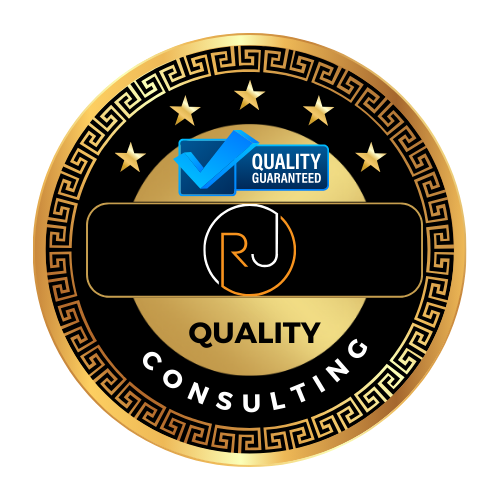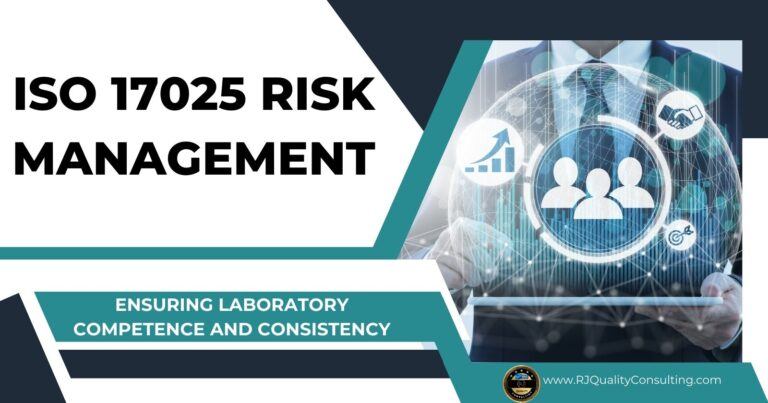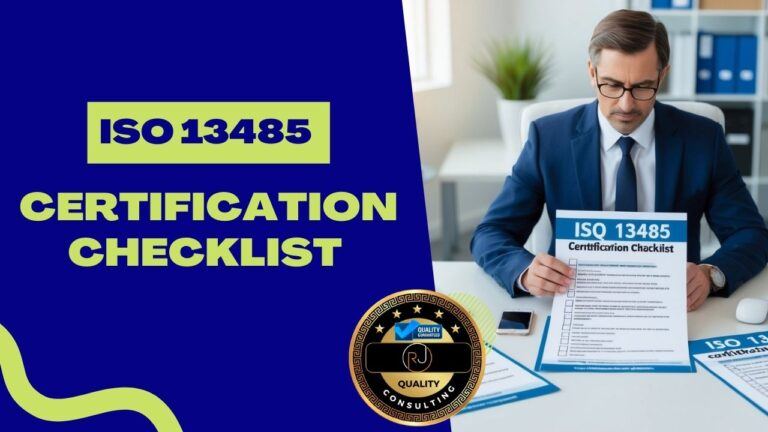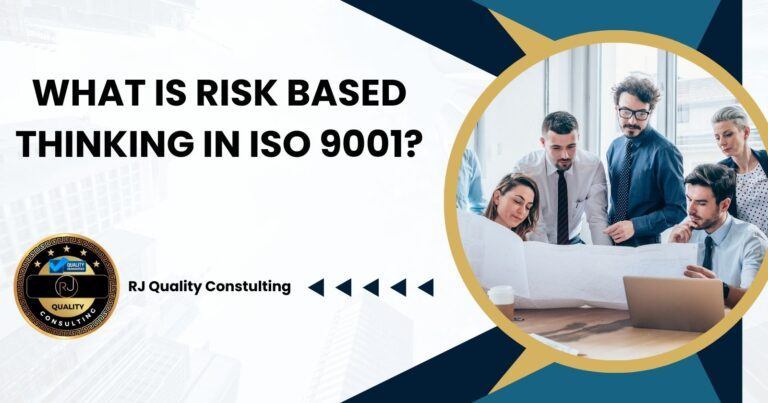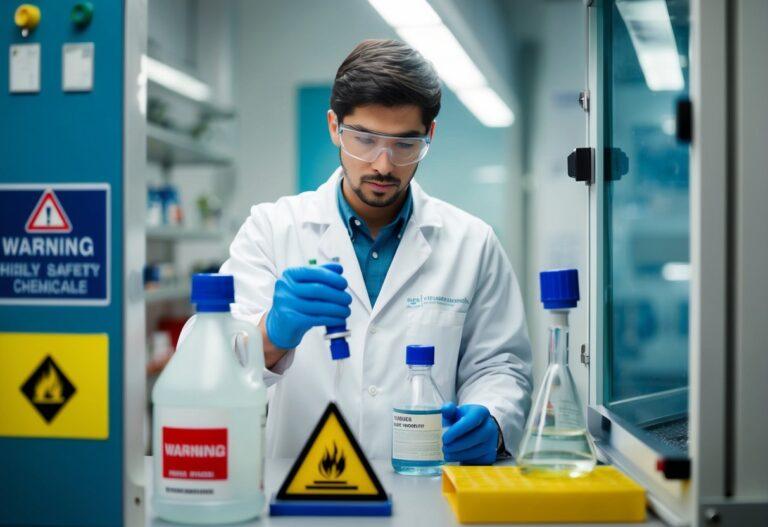Risk Management in ISO 13485: Essential Strategies for Medical Device Manufacturers
Risk management in ISO 13485 is a key part of making safe medical devices. ISO 13485 sets rules for quality control in the medical device industry. It tells companies how to find and deal with risks when making products. The 2016 update to ISO 13485 puts more focus on risk.

Companies need to think about risk at every step of making and selling medical devices. This includes designing, making, and watching products after they’re sold. The goal is to catch problems early and fix them. This helps keep patients safe and makes sure devices work well.
Risk management isn’t just about avoiding bad things. It’s also about finding ways to make products better. Risk management is now in most of the ISO standards such as ISO 17025 risk management. By looking at risks, companies can find new ideas to improve their devices. This can lead to safer and more effective medical tools.
Key Takeaways
- ISO 13485 guides medical device makers on managing risks
- Risk management covers the whole product lifecycle
- Addressing risks can lead to safer and better medical devices
Fundamentals of Risk Management in ISO 13485

Risk management is a key part of ISO 13485. It helps medical device makers find and deal with possible problems. This keeps products safe and meets rules. If your organization is not ISO 13485 certified, then you may want to do a risk assessment to see if becoming ISO 13485 certified is the best way to move forward. One of the first things you can do is create an ISO 13485 certification checklist.
Definitions and Core Concepts
Risk management in ISO 13485 means finding, checking, and lowering risks with medical devices. The main goal is to make sure devices are safe and work well.
Key terms include:
- Hazard: A possible source of harm
- Risk: The mix of how likely harm is and how bad it could be
- Risk analysis: Looking at what could go wrong
- Risk control: Steps to lower risks
You need to think about risks during the whole product life cycle. This includes design, making, and use of the device.
Objectives and Benefits of Risk Management
Risk management aims to make medical devices as safe as possible. It helps you spot problems early and fix them. This can save money and protect patients.
Benefits include:
- Better product quality
- Fewer recalls and complaints
- Meeting legal rules
- Building trust with customers
By doing good risk management, you can make smarter choices about your devices. You’ll know what risks are okay and which need more work. This helps you focus on the most important safety issues.
Relationship with ISO 14971
ISO 13485 works closely with ISO 14971, which is all about risk management for medical devices. ISO 14971 gives you more details on how to do risk management.
Key points:
- ISO 13485 says you must do risk management
- ISO 14971 tells you how to do it
You should use both standards together. ISO 14971 Risk Management helps you meet the risk parts of ISO 13485. It gives you steps to follow and ways to record your work.
Using both standards helps make sure your risk management is complete and follows the rules.
To get a visual and more detailed overview of how risk management is implemented in ISO 13485, check out the video below. It walks through the key steps you need to take to ensure compliance and safety in medical device manufacturing.
What is ISO 13485?
ISO 13485 is the international standard for quality management systems specific to medical devices. It ensures that medical devices are safe, reliable, and effective by setting regulatory and operational requirements for manufacturers. Compliance with this standard is critical for ensuring product quality and meeting global regulatory requirements in the medical device industry.
The Importance of Risk Management in ISO 13485
Risk management plays a crucial role in ISO 13485 because it ensures the safety of medical devices throughout their lifecycle. By identifying, assessing, and mitigating risks, companies can prevent potential failures or hazards that might affect patients or lead to non-compliance with regulations. Risk management ensures that devices remain safe and effective from design through production and even after they are in use.
How to Implement Risk Management in ISO 13485
Implementing risk management as part of your ISO 13485 system involves several key steps:
- Risk Identification: Begin by identifying potential risks related to product design, manufacturing, or use.
- Risk Assessment: Evaluate each identified risk by considering its likelihood and potential impact.
- Risk Mitigation: Develop and implement control measures to minimize or eliminate high-risk issues.
- Documentation: Maintain thorough records of risk management activities for compliance and internal tracking.
By following these steps, companies can proactively address risks and ensure safer medical devices.
Continuous Monitoring and Improvement
ISO 13485 emphasizes that risk management doesn’t end after product release. Continuous monitoring and improvement are essential for identifying new risks during post-market surveillance. Manufacturers must assess product performance, track customer feedback, and stay updated on regulatory changes to ensure that any emerging risks are managed effectively. This approach ensures the ongoing safety and quality of the device over its entire lifecycle.
Summary of Risk Management Steps in ISO 13485
Here is a quick summary of the essential steps in risk management for ISO 13485 compliance:
- Identify Risks: Recognize potential hazards in design, production, and post-market phases.
- Assess Risks: Evaluate the probability and severity of each identified risk.
- Mitigate Risks: Implement strategies to reduce or eliminate significant risks.
- Document: Keep detailed records of risk management activities.
- Monitor and Improve: Continuously review product performance and update risk controls as necessary.
These steps help ensure that your medical devices remain safe, effective, and compliant with ISO 13485 requirements.
Video Conclusion
Risk management is a foundational element of ISO 13485, helping medical device manufacturers create safe and compliant products. By implementing a systematic risk management process and maintaining ongoing monitoring, you can improve product quality and meet global regulatory standards.
If you have any questions or need more guidance on risk management in ISO 13485, feel free to leave a comment below or contact me for further support.
Risk Management Process

Risk management is a key part of ISO 13485. It helps you find and deal with risks in your medical device processes. This keeps your products safe and your quality system strong.
Risk Analysis
Risk analysis is the first step. You look at your products and processes to spot possible problems. Make a list of things that could go wrong. Think about how they might happen and what effects they could have.
Use tools like failure mode and effects analysis (FMEA) to help. This shows you which risks need the most focus. Score each risk based on how likely it is and how bad it would be.
Break down your device into parts. Look at each one to see where issues might come up. Don’t forget to check your manufacturing steps too.
Risk Evaluation
After finding risks, you need to decide which ones matter most. Look at your risk scores from the analysis step. Set levels for what risks you can accept and which need more work.
Make a chart to show your risk levels. This helps you see which risks fall above or below your cutoff point. Risks above the line need more attention.
Talk with your team about each risk. Use their knowledge to make sure you’re judging risks fairly. Keep notes on why you chose each risk level.
Risk Controls
Now it’s time to act on the big risks. Come up with ways to lower or get rid of them. You might change your design, add safety features, or improve your testing.
Make a plan for each risk control:
- What will you do?
- Who will do it?
- When will it be done?
Try to remove risks if you can. If not, add guards or warnings. Make sure your controls don’t create new risks.
Test your controls to make sure they work. Keep track of what you’ve done and how well it’s working.
Residual Risk Assessment
After you put controls in place, check what risks are left. These are your residual risks. See if they’re now at a level you can accept.
If some risks are still too high, you need more controls. Go back to the risk control step for those. Keep working until all risks are as low as you can get them.
Make a table of your residual risks. Show the original risk level and what it is now. This helps you see how much your controls have helped.
Risk Management Review
Set up times to look at your risk management work. Do this regularly and when things change. Check if new risks have come up or if old ones have changed.
Look at any problems that have happened. See if your risk management caught them or if you need to improve. Update your risk files with what you learn.
Keep records of all your reviews. Show what you looked at and any choices you made. This helps prove you’re following ISO 13485 rules.
Use what you find to make your risk process better. Your goal is to keep getting safer over time.
Risk Management Planning

Risk management planning is crucial for ISO 13485 compliance. It helps you identify potential issues and create strategies to handle them. A good plan keeps your medical device development on track and safe.
Establishing the Risk Management Plan
Your risk management plan sets the foundation for handling risks. Start by defining the scope and objectives. Include all stages of your device’s lifecycle. List the methods you’ll use to spot and assess risks.
Outline your risk acceptance criteria. This helps you decide which risks need action. Set up a system to track and review risks over time. Make sure your plan aligns with ISO 14971 standards.
Don’t forget to include how you’ll document everything. Good records are key for audits and continuous improvement.
Roles and Responsibilities
Clear roles make risk management smoother. Assign a risk management team leader. This person oversees the whole process.
Pick team members from different areas like engineering, quality, and regulatory. Each brings unique insights. Define what each person does. Who finds risks? Who analyzes them? Who decides on actions?
Set up a review process. Senior management should check and approve the plan. Make sure everyone knows their part. Train your team on risk management tools and techniques.
Regular meetings help keep everyone on the same page. Update roles as needed when your project changes.
Implementation and Operation of the Risk Management System

Putting a risk management system into action requires careful planning and execution. Key aspects include allocating resources, maintaining proper documentation, and ensuring traceability throughout the process.
Resource Allocation
You need to assign qualified personnel to manage risks effectively. This includes a risk management team leader and members with relevant expertise. Provide training to ensure everyone understands their roles and responsibilities.
Set aside time and budget for risk management activities. This covers risk assessments, mitigation efforts, and ongoing monitoring.
Invest in tools and software to support risk analysis and tracking. These can help you identify, evaluate, and document risks more efficiently.
Consider bringing in outside experts when needed. They can offer fresh perspectives and specialized knowledge for complex risk scenarios.
Documentation Requirements
Create a risk management plan outlining your approach and procedures. This serves as a roadmap for your team and demonstrates compliance to auditors.
Document all risk assessment activities, including:
- Hazard identification
- Risk estimation
- Risk evaluation
- Risk control measures
Keep records of risk control implementation and verification. This proves you’ve taken action to address identified risks.
Update your risk management file regularly. Include new information from post-market surveillance, customer feedback, and incident reports.
Traceability and Linkage
Establish clear links between identified hazards, risk control measures, and product requirements. This helps you track how risks are addressed throughout the product lifecycle.
Use a consistent numbering or coding system for risks and controls. This makes it easier to reference and update specific items.
Create traceability matrices to show connections between:
- Hazards and their associated risks
- Risks and their control measures
- Control measures and verification activities
Maintain links between risk management documents and other quality system records. This includes design documents, process validations, and user instructions.
Regularly review and update these linkages as your product or processes change. This ensures your risk management system remains current and effective.
Monitoring and Review

Keeping your risk management process up-to-date is crucial. Regular checks and updates help catch new risks and improve your approach over time.
Periodic Review and Updating
Set a schedule to review your risk management plan. Look at it every 6-12 months, or sooner if needed. Check if your risk controls are working well. See if any new risks have come up.
Update your risk assessment if you:
- Change your product design
- Get new safety data
- Hear about issues from customers
Make sure to document all reviews and changes. This helps you track your progress and show regulators you’re on top of things.
Feedback Mechanisms
Set up ways to get info about risks from different sources. Listen to what your customers say. Pay attention to complaints and product issues.
Create a system to collect and analyze this data. You might use:
- Customer surveys
- Complaint hotlines
- Social media monitoring
Train your staff to spot and report potential risks. Encourage open communication about safety concerns.
Use the feedback to improve your risk management. It can help you find risks you missed before. This makes your products safer and your company stronger.
Risk Management in Product Realization

Risk management plays a key role in medical device product realization. It helps ensure safety and quality at every stage. You’ll need to apply risk-based thinking to design, development, production, and post-production activities.
Design and Development
During design and development, you must identify and assess potential risks. Start by defining your device’s intended use. This will guide your risk analysis. Create a risk management plan outlining how you’ll handle risks throughout the product lifecycle.
Use tools like Failure Mode and Effects Analysis (FMEA) to spot possible issues. Consider both the likelihood and severity of potential harms. Document your risk assessment findings clearly.
Implement risk control measures to reduce risks to acceptable levels. This may involve design changes, protective measures, or user warnings. Test and validate these controls to make sure they work.
Production and Post-Production Activities
Risk management continues into production and beyond. Set up quality control checks to catch any issues before devices reach users. Train your staff on risk awareness and proper procedures.
Monitor your devices after release. Gather feedback from users and track any complaints or incidents. Use this data to update your risk assessments and improve future designs.
Keep detailed records of all risk-related activities. This helps with regulatory compliance and product improvements. Be ready to review and update your risk management processes as needed.
Remember, risk management is ongoing. Stay vigilant and proactive to ensure your medical devices remain safe and effective.
Post-Market Surveillance and Reporting

Post-market surveillance is crucial for maintaining medical device safety and effectiveness after market release. It involves gathering real-world data and analyzing it to identify potential issues or areas for improvement.
Information Gathering
You need to set up systems to collect data from various sources about your medical devices in use. This includes:
- Customer feedback and complaints
- Device malfunction reports
- Adverse event data
- Repair and maintenance records
- Scientific literature
Make sure to document all incoming information thoroughly. Set up clear processes for staff to report and log data. Use digital tools to organize and store the collected data securely.
Data Analysis and Reporting
Once you gather post-market data, analyze it to spot trends or potential safety issues. Look for:
• Common complaints or malfunctions • Unexpected adverse events • Device performance issues
Use statistical tools to identify significant patterns in the data. Prepare regular reports summarizing your findings. These reports should include:
• Key data points and trends • Risk assessments of any issues found • Proposed corrective actions if needed
Share relevant findings with your design and production teams to drive product improvements. Report serious issues to regulators as required by law.
Continuous Improvement in Risk Management
Risk management in ISO 13485 requires ongoing refinement and enhancement. You need to focus on improving strategies and managing changes to stay compliant and effective.
Improvement Strategies
To boost your risk management process, start by reviewing past issues. Look at problems that came up and see how you handled them. This helps spot weak points. Next, get input from your team. They often have good ideas for making things better.
Set clear goals for what you want to improve. Make a plan with steps to reach those goals. Track your progress along the way. Use data to see if your changes are working. If not, adjust your approach.
Regular training keeps your team up-to-date on best practices. Consider bringing in experts to share new methods. Stay current on industry trends and new tech that can help manage risks.
Change Management
When you make changes to your risk management system, be careful. Plan each change step by step. Think about how it might affect other parts of your process.
Tell your team about changes early. Explain why they’re needed and how they’ll help. Give people time to ask questions and share concerns. This helps everyone get on board.
Test changes on a small scale first if you can. This lets you fix problems before they affect everything. Keep close watch as you roll out changes. Be ready to make quick fixes if needed.
Document all changes you make. Note why you made them and what results you expect. Check back later to see if the changes worked as planned. If not, figure out why and try again.
Frequently Asked Questions
Risk management is a key part of ISO 13485. Here are answers to common questions about how to meet the standard’s requirements for managing risks in medical device production.
What are the best practices for implementing risk management procedures in line with ISO 13485?
Make risk management part of your whole process. Look at risks at each step of making and using your medical device. Train all staff on finding and handling risks. Keep good records of risks you find and what you do about them. Check your risk plans often to make sure they still work.
How does ISO 14971 relate to risk management within the context of ISO 13485?
ISO 14971 gives details on how to do risk management for medical devices. ISO 13485 says to use ISO 14971 methods. They work together to help you make safe devices. ISO 14971 shows how to find, judge, and control risks. It helps you meet the risk rules in ISO 13485.
What is the importance of documentation in the risk management process of ISO 13485?
Good records are key for risk management in ISO 13485. Write down all risks you find and what you do about them. Keep files on how you decided which risks matter most. Save proof of how you lower risks. These records show you follow the rules and help you track risks over time.
How should a risk assessment template be structured according to ISO 13485 standards?
A good risk form should list possible problems and their effects. Rate how likely each risk is and how bad it would be. Show how you plan to lower each risk. Leave space to note if your plans worked. Make sure the form lets you track risks through the whole device lifecycle.
How are risk analysis examples typically documented for compliance with ISO 13485?
Risk reports often use charts or tables. List each risk and rate how big it is. Show what you did to make the risk smaller. Note any new risks that came up when you tried to fix others. Add details on testing you did to check if your fixes worked. Keep these reports up to date as you learn more.
In what ways does ISO 13485 mandate risk management for medical device manufacturers?
ISO 13485 mandates that you must have a risk management plan. You need to find risks at all stages of making and using your device. The standard wants you to lower risks when you can. You have to keep checking for new risks. ISO 13485 also says to train staff on risks and keep good risk records.
🕒 Book Your Free 45-Minute Consultation
Have questions about ISO/IEC 17025 or ISO 9001 implementation or accreditation? Schedule a free 45-minute consultation with me to discuss your Company or laboratory’s needs and how we can achieve compliance together.
Schedule Your Consultation